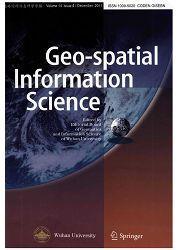Water color from Sentinel-2 MSI data for monitoring large rivers: Yangtze and Danube
IF 5.5
1区 地球科学
Q1 REMOTE SENSING
引用次数: 0
Abstract
Rivers provide key ecosystem services that are inherently engineered and optimized to meet the strategic and economic needs of countries around the world. However, limited water quality records of a full river continuum hindered the understanding of how river systems response to the multiple stressors acting on them. This study highlights the use of Sentinel-2 Multi-Spectral Imager (MSI) data to monitor changes in water color in two optically complex river systems: the Yangtze and Danube using the Forel-Ule Index (FUI). FUI divides water color into 21 classes from dark blue to yellowish brown stemming from the historical Forel-Ule water color scale and has been promoted as a useful indicator showing water turbidity variations in water bodies. The results revealed contrasting water color patterns in the two rivers on both spatial and seasonal scales. Spatially, the FUI of the Yangtze River gradually increased from the upper reaches to the lower reaches, while the FUI of the Danube River declined in the lower reaches, which is possibly due to the sediment sink effect of the Iron Gate Dams. The regional FUI peaks and valleys observed in the two river systems have also been shown to be related to the dams and hydropower stations along them. Seasonally, the variations of FUI in both systems can be attributed to climate seasonality, especially precipitation in the basin and the water level. Moreover, land cover within the river basin was possibly a significant determinant of water color, as higher levels of vegetation in the Danube basin were associated with lower FUI values, whereas higher FUI values and lower levels of vegetation were observed in the Yangtze system. This study furthers our knowledge of using Sentinel-2 MSI to monitor and understand the spatial-temporal variations of river systems and highlights the capabilities of the FUI in an optically complex environment.用于监测长江和多瑙河的Sentinel-2 MSI数据的水色
河流提供了关键的生态系统服务,这些服务本质上是经过设计和优化的,以满足世界各国的战略和经济需求。然而,整个河流连续体的有限水质记录阻碍了对河流系统如何响应多种压力源的理解。本研究重点利用Sentinel-2多光谱成像仪(MSI)数据,利用Forel-Ule指数(FUI)监测两个光学复杂的河流系统:长江和多瑙河的水色变化。FUI根据历史上的Forel-Ule水的颜色等级,将水的颜色分为深蓝色到黄褐色的21个等级,并被推广为显示水体中水浑浊度变化的有用指标。结果显示,在空间和季节尺度上,两条河流的水色模式形成了鲜明的对比。从空间上看,长江的FUI由上游向下游逐渐增大,而多瑙河的FUI在下游呈下降趋势,这可能与铁门坝的泥沙汇效应有关。在两个水系中观测到的区域FUI峰值和低谷也被证明与水坝和水电站有关。在季节上,两个系统的FUI变化可归因于气候季节性,特别是流域降水和水位。此外,河流流域内的土地覆盖可能是水色的重要决定因素,因为多瑙河流域的植被水平较高,其FUI值较低,而长江水系的FUI值较高,植被水平较低。这项研究进一步加深了我们使用Sentinel-2 MSI监测和理解河流系统时空变化的知识,并强调了FUI在光学复杂环境中的能力。
本文章由计算机程序翻译,如有差异,请以英文原文为准。
求助全文
约1分钟内获得全文
求助全文
来源期刊

Geo-spatial Information Science
REMOTE SENSING-
CiteScore
10.10
自引率
28.30%
发文量
710
审稿时长
31 weeks
期刊介绍:
Geo-spatial Information Science was founded in 1998 by Wuhan University, and is now published in partnership with Taylor & Francis. The journal publishes high quality research on the application and development of surveying and mapping technology, including photogrammetry, remote sensing, geographical information systems, cartography, engineering surveying, GPS, geodesy, geomatics, geophysics, and other related fields. The journal particularly encourages papers on innovative applications and theories in the fields above, or of an interdisciplinary nature. In addition to serving as a source reference and archive of advancements in these disciplines, Geo-spatial Information Science aims to provide a platform for communication between researchers and professionals concerned with the topics above. The editorial committee of the journal consists of 21 professors and research scientists from different regions and countries, such as America, Germany, Switzerland, Austria, Hong Kong and China.
 求助内容:
求助内容: 应助结果提醒方式:
应助结果提醒方式:


